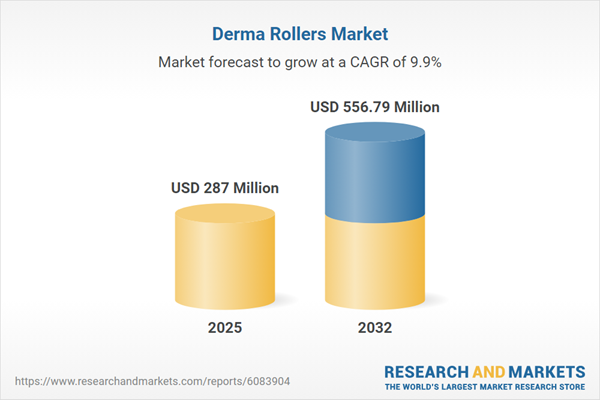Speak directly to the analyst to clarify any post sales queries you may have.
The derma rollers market is rapidly evolving as advancements in microneedling technology align with the shifting expectations of both clinical professionals and at-home users. Strategic adoption by healthcare providers and growing consumer awareness are shaping the current and future landscape for sector decision-makers seeking agile, informed approaches.
Market Snapshot: Derma Rollers Market Growth and Opportunity
The global derma rollers market grew from USD 261.01 million in 2024 to USD 287.00 million in 2025. This robust trajectory, with a compound annual growth rate (CAGR) of 9.93%, is expected to drive the market to USD 556.79 million by 2032. Expansion is being fueled by broader acceptance of microneedling for skin rejuvenation in both clinical and household environments. Increasingly, a diverse buyer mix—including healthcare professionals and individual consumers—are supporting sustained market demand for derma rollers solutions.
Scope & Segmentation
- Product Type: Electronic and manual derma rollers address the needs of both advanced clinical practices and routine consumer care.
- Application: Devices are applied in both clinical and at-home environments, serving procedures ranging from professional treatments to everyday skincare routines.
- Distribution Channel: Products reach end users through beauty centers, hospital pharmacies, online retail, and specialty stores, illustrating a multi-channel strategy.
- Needle Size: Options include ranges from less than 0.25 mm up to needles greater than 1.0 mm, empowering users to select tools tailored for various skin concerns and procedures.
- End User: Beauty centers, dermatology clinics, and household consumers form the primary user groups, driving innovation and product adaptation to address specialized needs.
- Sales Channel: Both offline channels (clinics, pharmacies, specialty stores) and online platforms support broad access and cater to buyer preferences regarding consultation and convenience.
- Geographic Coverage: The market spans Americas (including United States, Canada, Mexico, Brazil, Argentina, Chile, Colombia, Peru); Europe, Middle East & Africa (with United Kingdom, Germany, France, Russia, Italy, Spain, Netherlands, Sweden, Poland, Switzerland, United Arab Emirates, Saudi Arabia, Qatar, Turkey, Israel, South Africa, Nigeria, Egypt, Kenya); and Asia-Pacific (covering China, India, Japan, Australia, South Korea, Indonesia, Thailand, Malaysia, Singapore, Taiwan).
- Key Companies: Sector landscape includes Dermaroller GmbH, Chance Industries, LLC, Sdara Skincare, Inc., BeautyBio, Inc., ORA Micro-Needling, LLC, Zhongshan ZGTS Medical Instruments Co., Ltd., Mt. Lai, LLC, RoselynBeauty, LLC, Saint Cosmetics, LLC, and Bioscience International, LLC. These organizations influence product innovation, channel partnerships, and user outreach.
Key Takeaways for Senior Decision-Makers
- Integration of microneedling technology within both manual and electronic devices supports flexible adaptation for clinical professionals and consumers, ensuring that varied application scenarios are addressed.
- Device design continues to progress, with smart features and customizable needle depths improving procedural outcomes and patient or user experiences—particularly in dermatology clinics and at-home use.
- Distribution is shaped by a dual approach: professional purchases through clinics and specialty outlets are complemented by a rise in direct-to-consumer online sales and the inclusion of subscription-based offerings.
- Demographics now include a broader mix, as beauty centers and dermatology practices lead technology demonstrations, while individual consumers increasingly value robust educational support and confidence in quality standards.
- There is growing emphasis on sustainability and regulatory compliance. Factors such as sterilization practices, reusable design elements, and material safety are now critical both for purchasing decisions and for supplier competitiveness.
Tariff Impact on Sourcing and Supply Chain Resilience
Recent United States tariffs on imported microneedling components have led to higher production costs, prompting manufacturers to reconsider supplier networks. Strategic approaches include supplier diversification, nearshoring, and greater investment in domestic capabilities. Stakeholders—distributors, clinics, and suppliers—are also re-calibrating inventory strategies and contract agreements to secure continuity of treatment and contain operational costs. Increased industry collaboration is enabling more agile supply chains, helping participants navigate evolving tariff conditions and promoting resilience across the derma rollers industry.
Research Methodology & Data Sources
This report utilizes a blend of primary and secondary research to ensure comprehensive, actionable market intelligence. Expert interviews, practitioner surveys, and end-user feedback form the foundation of primary data, while regulatory filings, peer-reviewed sources, trade association documents, and official company reports provide rigorous secondary validation. Combined, these methods deliver reliable analyses for senior market stakeholders.
Why This Report Matters for Decision-Makers
- Provides actionable support for sourcing strategies in the face of supply chain challenges and changing tariff regulations specific to derma rollers.
- Enables the tailoring of product, channel, and regulatory strategies to emerging trends, empowering more informed market positioning across regions and buyer groups.
- Delivers guidance for innovation planning, including the adoption of smart device features and pursuit of sustainability goals within device portfolios and partnerships.
Conclusion
The derma rollers market is advancing through product innovation, expanding use cases, and evolving supply and regulatory dynamics. This report offers insights to inform effective strategic decisions and build long-term market leadership.
Table of Contents
3. Executive Summary
4. Market Overview
7. Cumulative Impact of Artificial Intelligence 2025
Companies Mentioned
The companies profiled in this Derma Rollers market report include:- Dermaroller GmbH
- Chance Industries, LLC
- Sdara Skincare, Inc.
- BeautyBio, Inc.
- ORA Micro-Needling, LLC
- Zhongshan ZGTS Medical Instruments Co., Ltd.
- Mt. Lai, LLC
- RoselynBeauty, LLC
- Saint Cosmetics, LLC
- Bioscience International, LLC
Table Information
| Report Attribute | Details |
|---|---|
| No. of Pages | 190 |
| Published | November 2025 |
| Forecast Period | 2025 - 2032 |
| Estimated Market Value ( USD | $ 287 Million |
| Forecasted Market Value ( USD | $ 556.79 Million |
| Compound Annual Growth Rate | 9.9% |
| Regions Covered | Global |
| No. of Companies Mentioned | 11 |









